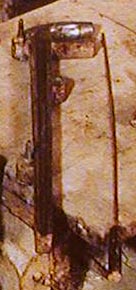|
Altogether, the Society has held 16 meetings
at which the results of local and regional studies have been reported.
The meetings have also heard about research in neighbouring countries:
Italy, Holland, Austria, Poland, Switzerland and Russia.
Particular attention should be drawn to reports on evaluation
of material from the excavation of Casselmann's clay pipe factory
in Hannoversch Münden (Gerhard Almeling), and the large amounts
of material from the Veste Oberhaus in Passau (Martin Kügler),
Einbeck (Andreas Heege), N. Germany (Rüdiger Articus, Maren
Weidner), Leipzig (Ralf Kluttig-Altmann), and from Switzerland (Michael
Schmaedecke). Historical studies are mostly concerned with
the development of clay-pipe making in individual areas and places,
e.g. in Westerwald, Ruhla and Holzminden, as well as with trade
routes. Tobacco growing and its subsequent processing, the
different forms of taking tobacco by the consumer, and the
development of tobacco pipes made of other materials such
as wood, porcelain or meerschaum (Walther Morgenroth) are topics
that were also dealt with in the meetings.
Archaeological studies combined with evaluation of historical documents
have demonstrated the importance of Dutch clay-pipe production,
especially that of Gouda, for the European market in the 17th and
18th centuries. A particularly interesting aspect is that Dutch
pipes were widely copied, i.e. the designs pirated. These imitations
often not only show a bowl shape and decoration typical of
the Dutch clay pipes but also have a Dutch pipe-maker's mark and
even an inscription on the stem giving a Dutch pipe-maker's name
and home town. At the same time as these imitations were produced,
German production centres also produced their own clay-pipe designs
stamped with their own trade-marks, commonly permitting the pipes
to be traced back to the individual factories. Thus, identification
of these in excavated material found in several different places
allows conclusions to be drawn as to where the pipes were marketed,
transport routes, and other details about the clay-pipe trade.
Products from the Rhine-Neckar region (Mannheim, Frankenthal), from
Westerwald, southern Lower Saxony and northern Hesse (Grossalmerode,
Uslar, Walbeck etc.) and from Saxony (Grimma) are relatively frequently
found in excavations. However, there are still numerous pipes excavated
in Bavaria which are certainly of German origin, but which cannot
yet be connected with a definite production centre.
|
|

A pipe maker's workbench - zoom
|

